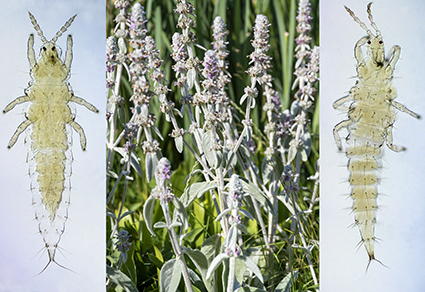Abstract
This paper presents morphological description and images of the larval instars of Neoheegeria dalmatica as well as observations on its life cycle and relationships with host plants in a temperate climate. It also compares characteristics of the second larval instar with those of Haplothrips verbasci, i.e. a species previously placed in the genus Neoheegeria. The main characteristic that differentiates the larvae of both species is, among others, the sculpture of their cuticle, which is smooth in H. verbasci and covered by dense microtrichia in N. dalmatica.
References
- Collins, W.D. (2007) Two species of thrips (Thysanoptera) new to Britain, Neoheegeria dalmatica Schmutz and Frankliniella pallida (Uzel), with an updated key to the British species of Frankliniella Karny. British Journal of Entomology and Natural History, 20 (4), 242–248.
- Collins, W.D. (2010) Thysanoptera of Great Britain: A revised and updated checklist. Zootaxa, 2412 (1), 21–41. https://doi.org/10.11646/zootaxa.2412.1.2
- Dang, L.-H., Le, Z., Xia, W. & Qiao, G.-X. (2019) Review of Podothrips from China (Thysanoptera, Phlaeothripidae), with one new species and three new records. ZooKeys, 882, 41–49. https://doi.org/10.3897/zookeys.882.39029
- Degabriele, G., Cavalleri, A., Goldarazena, A. & Mifsud, D. (2023) The Tubulifera (Hexapoda, Thysanoptera) of the Maltese Island. ZooKeys, 1180, 201–223. https://doi.org/10.3897/zookeys.1180.107065
- Kobro, S. & Rafoss, T. (2001) Diagnostic characters of the larvae of some Hoplothrips species (Thysanoptera: Tubulifera) in Norway. European Journal of Entomology, 98, 543–546. https://doi.org/10.14411/eje.2001.068
- Kucharczyk, H. (2007) Wciornastki (Thysanoptera). In: Bogdanowicz, W., Chudzicka, E., Pilipiuk, I. & Skibińska, E. (Eds.), Fauna Polski. Charakterystyka i wykaz gatunków t. II, Muzeum i Instytut Zoologiczny, Warszawa, pp. 391–398. [in Polish]
- Kucharczyk, H. (2010) Comparative morphology of the second larval instar of the Thrips genus species (Thysanoptera: Thripidae) occurring in Poland. Mantis Publishing Company, Olsztyn, 152 pp.
- Kucharczyk, H. (2022) Neoheegeria dalmatica Schmutz, 1909 In: Digital Catalogue of Biodiversity of Poland—Animalia: Arthropoda: Hexapoda: Insecta: Thysanoptera. Version 1.3. Polish Biodiversity Information Network. Checklist dataset. via GBIF.org. https://doi.org/10.15468/a4vvz3
- Kucharczyk, H. & Kucharczyk, M. (2008) The Red List of Threatened Thrips Species (Thysanoptera, Insecta) of Middle-Eastern Poland. Acta Phytopathologica et Entomologica Hungarica, 43 (2), 297–305. https://doi.org/10.1556/APhyt.43.2008.2.13
- Kucharczyk, H. & Stanisławek, K. (2020) Haplothrips second instar larvae (Thysanoptera: Phlaeothripidae); character states and key to Central European species. Zootaxa, 4845 (3), 375–392. https://doi.org/10.11646/zootaxa.4845.3.4
- Minaei, K., Azemayeshfard, P. & Mound, L.A. (2007) The southern Palearctic genus Neoheegeria (Thysanoptera: Phlaeothripidae): redefinition and key to species. Tijdschrift voor Entomologie, 150, 55–64. https://doi.org/10.1163/22119434-900000212
- Minaei, K. & Behmanesh, M. (2012) First record of Neoheegeria gigantea (Thys.: Phlaeothripidae) from Iran. Journal of Entomological Society of Iran, 32 (1), 135–136.
- Minaei, K. & Mound, L.A. (2008) The Thysanoptera Haplothripini (Insecta: Phlaeothripidae) of Iran. Journal of Natural History, 42 (41–42), 2617–2658. https://doi.org/10.1080/00222930802354159
- Minaei, K., Fekrat L. & Mound, L. (2018) The genus Neoheegeria with a new species from Iran exhibiting wing-dimorphism (Thysanoptera: Phlaeothripidae). Zootaxa, 4455 (3), 563–570. https://doi.org/10.11646/zootaxa.4455.3.12
- Mound, L.A. (2005) Thysanoptera: Diversity and Interactions. Annual Review of Entomology, 50, 247–69. https://doi.org/10.1146/annurev.ento.49.061802.123318
- Mound, L.A. (2013) Homology and host-plants specificity: recurrent problems in the study on thrips. Florida Entomologist, 96 (2), 318–322. https://doi.org/10.1653/024.096.0250
- Mound, L.A. & Kibby, G. (1998) Thysanoptera, an identification guide. 2nd Edition. C.A.B. International. Wallingford, Oxon, 70 pp.
- Priesner, H. (1964) Ordnung Thysanoptera (Fransenflügler, Thripse). In: Franz, H. (Ed.), Bestimmungsbücher der Bodenfauna Europas. Vol. 2. Akademie-Verlag, Berlin, pp. 1–242.
- Stanisławek, K. & Kucharczyk, H. (2012) Comparative morphology of the second larval instar of Haplothrips setiger, H. jasionis and H. statices (Thysanoptera, Phlaeothripidae). Acta Phytopathologica et Entomologica Hungarica, 47 (1), 141–150. https://doi.org/10.1556/APhyt.47.2012.1.18
- Schliephake, G. & Klimt, K. (1979) Thysanoptera, Fransenflügler. Die Tierwelt Deutschlands, 66, 1–477.
- Uzun Yigut, A., Demirozer, O. & Minaei, K. (2022) Thrips species associated with cereals of the Lakes Region of Turkey with new records. Mediterranean Agricultural Sciences, 35 (1), 15–19. https://doi.org/10.29136/mediterranean.1040263
- Zawirska, I. (1988) Thysanoptera collected in Poland. Fragmenta Faunistica, 31 (13), 361–402. https://doi.org/10.3161/00159301FF1988.31.13.361


